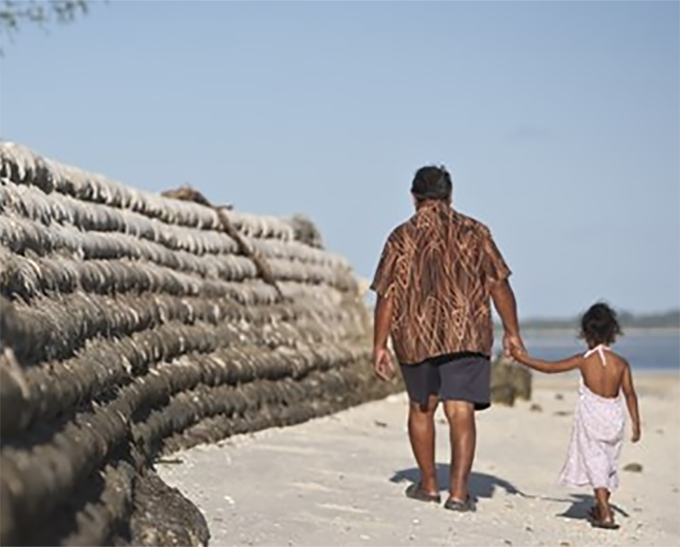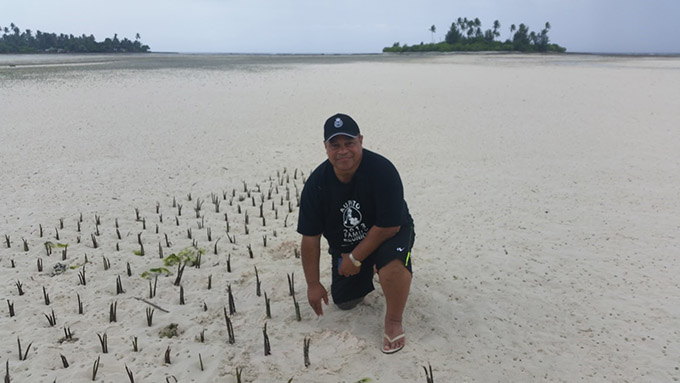AsiaPacificReport.nz
[embedded content]
Ice melt, sea level rise and superstorms … Professor Hansen speaks on the science and implications. Video: Climate Science, Awareness and Solutions
An “alarming” new study by Professor James Hansen predicts rapid sea level rise and more intense superstorms. What could this mean for Pacific nations? Dominic Pink reports for Asia Pacific Report.
Last month was the hottest March on record, according to satellite data. This follows the hottest February on record, and a December-February warm streak which set a record for the highest departure from average global temperature for any three-month period.
March also saw the publication of a “bombshell” new climate change study by Professor James Hansen and 18 co-authors, which has been making waves in the media and inspiring much debate among climate scientists.
Hansen, considered “the father of climate change awareness”, outlines a scenario where a growing ice melt could cause 2 to 5 metres of sea level rise by the end of the century if global warming stays at 2° C – significantly faster than the less-than-1 metre projected by the Intergovernmental Panel on Climate Change (IPCC).
“A more immediate threat is the likelihood of shutting down the oceans’ overturning circulations in the North Atlantic and Southern Ocean,” Hansen says in his accompanying video address, detailing a previously uncovered feedback link between the oceans and giant ice sheets in Antarctica and Greenland.
“These feedbacks raise questions about how soon we will pass points of no return in which we will lock-in consequences that cannot be reversed on any time scale that people care about.”
Hansen describes a future with “superstorms stronger than any in modern times” and the potential “loss of all coastal cities, most of the world’s largest cities and all of their history”.
Plausible and ‘alarming’
Commenting on Hansen’s study, Professor James Renwick of Victoria University found the research to be plausible and “alarming”, although he thinks the time scale of change will be slower than Hansen suggests.

“Having said that, there is an important message here. Even if it takes 200 years rather than 50 years, we may well already be locked-in to very large changes in sea level and climate.”
Jason Garman of Oxfam NZ considers the study to be “another in a long line of serious warnings from the best climate scientists in the world that we’re not taking action fast enough”.
“If we’re going to have several metres of sea level rise within 50 years, 150 years or 250 years, we’re still talking about ultimately the same thing, which is … the potential end of cultures here in the Pacific that have been around for tens of thousands of years. This is a tremendous injustice and it should be a wake-up call.”
A recent study by the United Nations University Institute for Environment and Human Security (UNU-EHS) found that nearly everyone surveyed on the low-lying Pacific Island nations of Kiribati, Tuvalu and Nauru had been affected by climate change.
Sea level rise, saltwater intrusion, droughts and floods have resulted in forced migration, with 23 percent of migrants in Kiribati naming climate change as a reason to relocate, and 70 percent of households seeing migration as a likely response if conditions worsened.
In May 2014, Kiribati’s government purchased 2430ha of land in Fiji, where its 110,000 population would potentially relocate to avoid a humanitarian crisis should sea levels continue to rise.

Fact-finding mission
Labour Party’s Pacific Climate Change spokesperson Su’a William Sio has just returned from a fact-finding mission to Kiribati and Tuvalu.
“For the rest of the world climate change might be an emerging issue, but for these Pacific Islands it is a present issue, they’re having to deal with it on a day-to-day basis.”
Sio encountered many young i-Kiribati voicing disappointment over what they see as New Zealand and Australia “dragging their feet” over addressing climate change.
“On a number of levels we’ve got this connection with the Pacific, and we do have a responsibility to step up and stand in solidarity with them,” Sio says.
“There’s a real need for us to have a long-term migration with dignity plan in place … What I saw was some of the outer islands of both Tuvalu and Kiribati are no longer inhabitable because of constant flooding with their rising tides. So we’ve got to help these islands plan for migration.”
In the wake of the “historic” Paris climate agreement, Sio shared i-Kiribati concerns, saying “the international community patted itself on the back last year… but so far there is no action that is going to reduce global warming right now… at the moment the Pacific are fighting for their lives.”
Paula Bennett, the National government’s Minister for Climate Change, responded by highlighting that next week New Zealand will sign the Paris climate agreement, which “will serve as the foundation of the action the world takes to transition to a low carbon economy.”
Ratification next
“Our next steps are to work on the operational details of the agreement that will enable us to move towards domestic ratification.”
Bennett also said New Zealand had committed to spending $200 million to “support our Pacific friends and neighbours adapt to the effects of climate change”.
While acknowledging that Paris “was a great diplomatic achievement”, Renwick worries that it may “lull us into a false sense of security”, and he remains critical of National’s climate change policy.
“The government’s plan to meet targets involves buying emissions credits from overseas — riding on the efforts of others — and by use of the ETS (Emissions Trading Scheme), which is completely ineffective”.
Bennett explained that the global market for emissions credits is “a key way to help us meet our targets while we work on a long-term plan to make genuine changes to our economy.”
“This is especially true for sectors that cannot quickly or affordably lower their emissions without gutting businesses and potentially impacting on New Zealanders’ jobs. We need fewer emissions going into the atmosphere, and it doesn’t practically matter where these reductions come from.
“Buying emissions from others like developing nations is also an important way of supporting those countries attempting to grow in a sustainable way.”
Renwick, however, urges more action, pointing to the Green Party’s 2015 plan for reducing emissions as an ideal for New Zealand.
“We need proper carbon pricing, a move away from dairying, electrification of the car fleet, and investment on public transport.”
Dominic Pink is an Auckland-based student journalist reporting on AUT’s Asia-Pacific Journalism course.
–]]>







